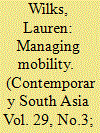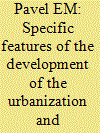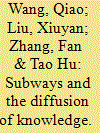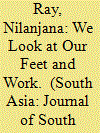| Srl | Item |
| 1 |
ID:
180056


|
|
|
|
|
| Summary/Abstract |
Drawing on ethnographic fieldwork in Kolkata and rural West Bengal and engaging with literature on mobile phones in the global South, and on gender and sexuality in India, this article seeks to understand the incongruence between widespread mobile phone use in India and commuting domestic workers’ own accounts of their mobile phone use. It illustrates the important role that mobile phones play in enabling commuting workers (who are mostly women) to find work and manage relationships, but also how commuting workers play down their mobile phone use, guarding against suspicion from husbands, sons, and others. Such suspicion reflects the stigma around women’s mobility/sexuality, connected to ideas about women’s ‘honour’ and the perceived risks associated with women’s work and journeys. When workers’ mobile phone use is, then, perceived to be ‘inappropriate’, or if workers transgress norms and expectations relating to ideas about women’s ‘honour’ in other ways, they can face (further) surveillance and abuse, their access to phones thereafter often being controlled by men. Contributing to gendered analyses of mobile phones in the global South, the article shows how phones can at once create new possibilities and freedoms for commuting domestic workers while at the same time reinforcing gendered power relationships.
|
|
|
|
|
|
|
|
|
|
|
|
|
|
|
|
| 2 |
ID:
118589


|
|
|
|
|
| Publication |
2012.
|
| Summary/Abstract |
The author of the article examines the specific features of the development of urbanization in the Republic of Korea and its influence on the system of urban settlement of the country's population in the latter half of the 20th-beginning of the 21st centuries. He also describes the role of urbanization in intensified commuting and greater disproportion of population distribution.
|
|
|
|
|
|
|
|
|
|
|
|
|
|
|
|
| 3 |
ID:
186951


|
|
|
|
|
| Summary/Abstract |
This paper aims to examine the role of the subway network, a typical form of transportation within urban areas, on innovation and knowledge diffusion. Applying the difference-in-differences strategy and spatial analysis, we used 1,332 newly opened stations in China from 2000 to 2013 as a quasi-experiment to identify the local effects of subway expansions. Results suggested that by reducing communication costs and increasing opportunities for interaction, subway construction would bring growth at the district level. Knowledge dissemination would become more active after new stations open. Micro-level results showed that these positive impacts were highly localized; that is, only those firms located within 1km around stations benefited from the new subway. Moreover, new subways facilitated the flow of knowledge from station to station and assisted firms in acquiring knowledge from more distant technology clusters conveniently.
|
|
|
|
|
|
|
|
|
|
|
|
|
|
|
|
| 4 |
ID:
191701


|
|
|
|
|
| Summary/Abstract |
This is a case study of women workers in the informal construction sector who commute daily to the city of Kolkata in eastern India. While existing studies of women construction workers have considered their worker identity as primary, this study offers an alternative theorising, reading them as women whose identity as workers is embedded in other social identities. In-depth interviews with these women reveal that entrenched patriarchal norms and gender discrimination create structural vulnerabilities, which are in turn compounded by the risk of sexual abuse in the workplace. Nevertheless, the women exercise agency and access jobs with favourable wages through bonding and bridging relationships in a sector dominated by men.
|
|
|
|
|
|
|
|
|
|
|
|
|
|
|
|